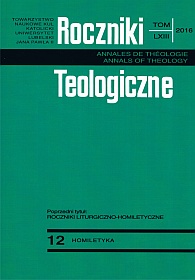The Image of the Triune God in the Liturgy
Abstract
Liturgy does not only express the events of salvation in the perspective of the heavenly liturgy. Beyond its causative dimension − that is, its action ex opero operato − with respect to the saving mystery of God, it is a symbol of this same mystery, an image, even, of it. In this context the imagery of the liturgy must be properly understood, and to this end, the significance also of the attributed symbol. Alexander Schmemann says that in the original understanding, a symbol is a manifestation and a presence of another reality, which in given conditions may not be exhibited other than in and through this reality. An external likeness between the visible dimension of the symbol and the thing it actually symbolizes, while not essential, and can sometimes even trivialize the symbol, is not however uncommon. This pertains particularly to the Church itself and its liturgy, where symbolism has been shaped by salvation history and has a source of its own in Sacred Scripture. Thus it is possible, and even necessary, to speak of the symbolic imagery of the whole liturgical celebration.
The Church and its liturgy are a reflection of the Most Holy Trinity, since they are the common action of the three Divine Persons. The Church is the principle tool of the work of salvation and its continuation in time, but it also carries within it an internal symbol/image of the unity and love of the Persons of the Most Holy Trinity and their outward mission/message. Cardinal Tomáš Špidlík shows this on the basis of the theology of the Fathers of the Church in relation to the teachings of Vatican II.
Liturgical theology presents the trinitarian source of Christian love and unity as well as Christian solidarity. The communion of the Persons of the Holy Trinity, revealing itself in every liturgy and especially in the Eucharist, is the source of all unity − from unity within the Church and between particular ecclesial communities to every type of human connection.
References
Casel O., Die Liturgie als Mysterienfeier, Freiburg: Herder 19233.
Casel O., Mysterium der Ekklesia. Von der Gemeinschaft aller Erlösten in Christus Jesus. Aus Schriften und Vorträgen, Mainz: Matthias-Grünewald-Verl. 1961.
Klauza K., Teologiczna hermeneutyka ikony, Lublin: RW KUL 2002.
Lukken G., Nella liturgia la fede si realizza in modo insostituibile, „Concilium”. Rivista internazionale di teologia 9(1973), z. 2, s. 31-42.
Marsili S., Teologia liturgica, w: Nuovo dizionario di liturgia, red. D. Sartore, A.M. Triacca, Roma: Ed. Paoline 19842, s. 1508-1525.
Migut B., Teologia liturgiczna szkoły rzymskiej, Lublin: Wydawnictwo KUL 2007.
Schmemann A., Eucharystia – misterium Królestwa, Białystok: Orthdruk 1997.
Świerzawski W., Pro cuius amore, Wrocław: WWKA 1984.
Špidlík T., Zanurzeni w Trójcy. Krótkie studium o Trójcy Świętej, Kraków: Wydawnictwo OO. Franciszkanów „Bratni Zew” 2003.
Triacca A.M., La structure trinitaire des „Preces Eucharisticae” dans la liturgie ambrosienne (Hier et aujourd'hui), w: Trinité et Liturgie. Conférences Saint-Serge, XXXe Semaine d'études liturgiques. Paris, 28 juin-1er juillet 1983, red. A.M. Triacca, A. Pistoia (Bibliotheca Ephemerides Liturgicae, Subsidia 32), Roma: Edizioni Liturgiche 1984, s. 301-384.
Triacca A.M., Anno Liturgico: „icona” del rapporto tra l'„hodie” e l'„eschaton”, „Rivista Liturgica” 75(1988), s. 473-485.
Vagaggini C.: Prospetto di un saggio su simbolismo e linguaggio teologico, w: Symbolisme et Théologie (Sacramentum 2), Roma: Editrice Anselmiana 1974, s. 290-311.
Copyright (c) 2016 Roczniki Teologiczne

This work is licensed under a Creative Commons Attribution-NonCommercial-NoDerivatives 4.0 International License.





